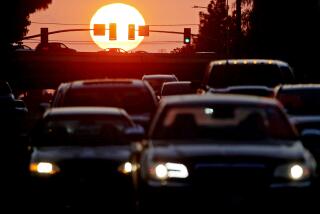Lane-Hoppers Alert: Other Cars Not Moving as Fast as They Seem
- Share via
The urge to change lanes while driving may be caused by an optical illusion that convinces people the cars in the other lane are going faster, according to a new study.
The basic problem is that cars spread out when they’re going quickly and bunch up when they slow down, said Donald Redelmeier, a professor of medicine at the University of Toronto. So when you pass a bunch of slower cars in the other lane, it happens fairly quickly. But if you are passed by the same cars while your lane slows temporarily, they go by one by one.
That leads to the illusion that the other lane is moving faster.
Redelmeier’s advice: “Resist small temptations to change lanes.”
In the Sept. 2 issue of the journal Nature, Redelmeier and a Stanford University statistician reported the results of computer simulations of traffic.
They showed that a driver can spend more time being overtaken by cars in the other lane than in passing them, even though both lanes travel at the same average speed.
“So you’re going to have many more moments of frustration to balance the relatively few moments of pleasure,” Redelmeier said.
The researchers also showed 120 driving students a videotape of an adjacent lane of real traffic, depicting a side view from the back seat of a car. About 70% believed the traffic they saw was going faster than the car with the camera, when in fact it was going slightly slower, on average.
Robert Ervin, head of the engineering research division at the University of Michigan’s Transportation Research Institute, said the study offers “a great hypothesis.”
“It is an important and interesting issue that deserves more attention,” especially with experiments that follow real drivers in their vehicles, he said.






